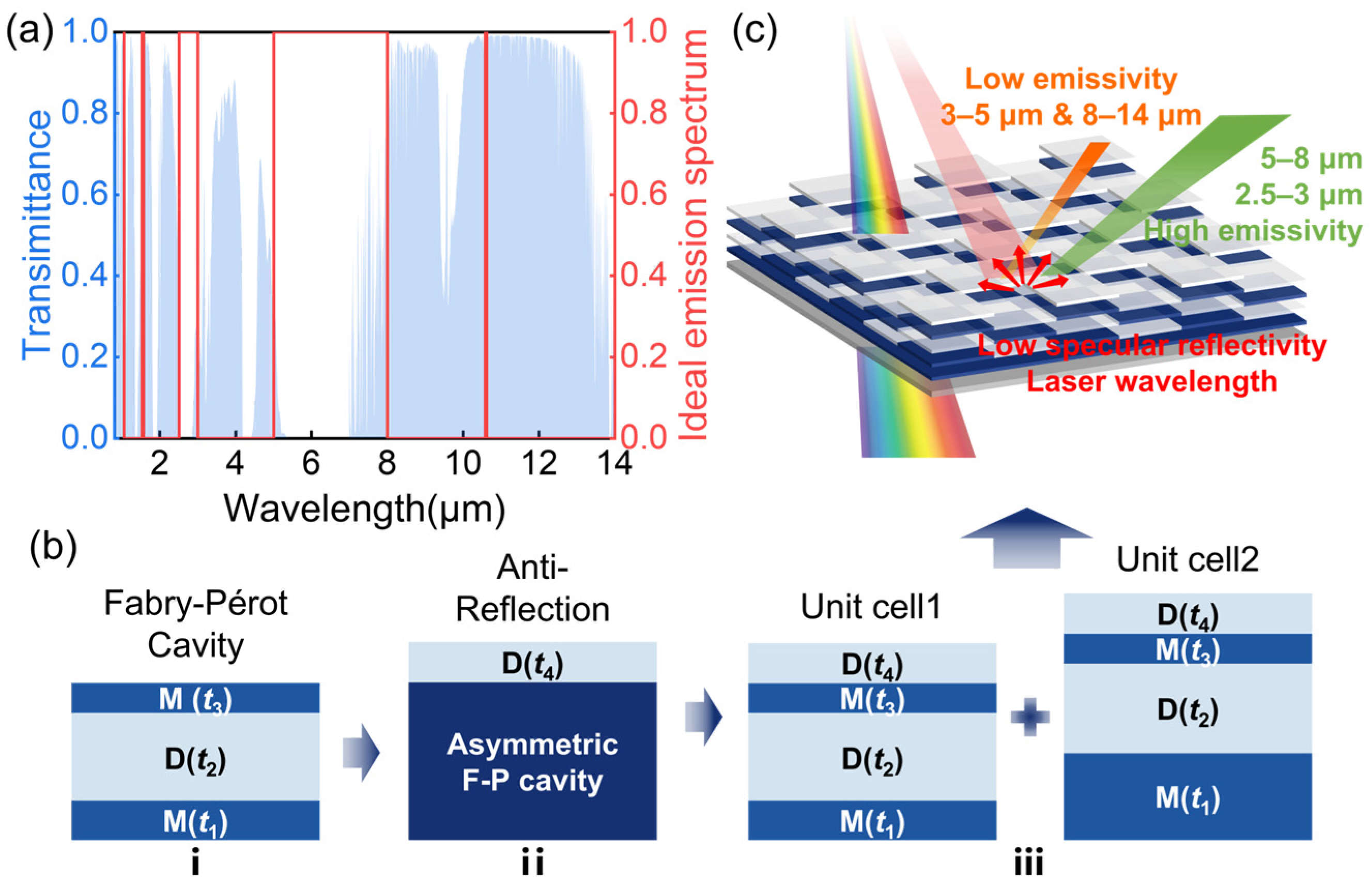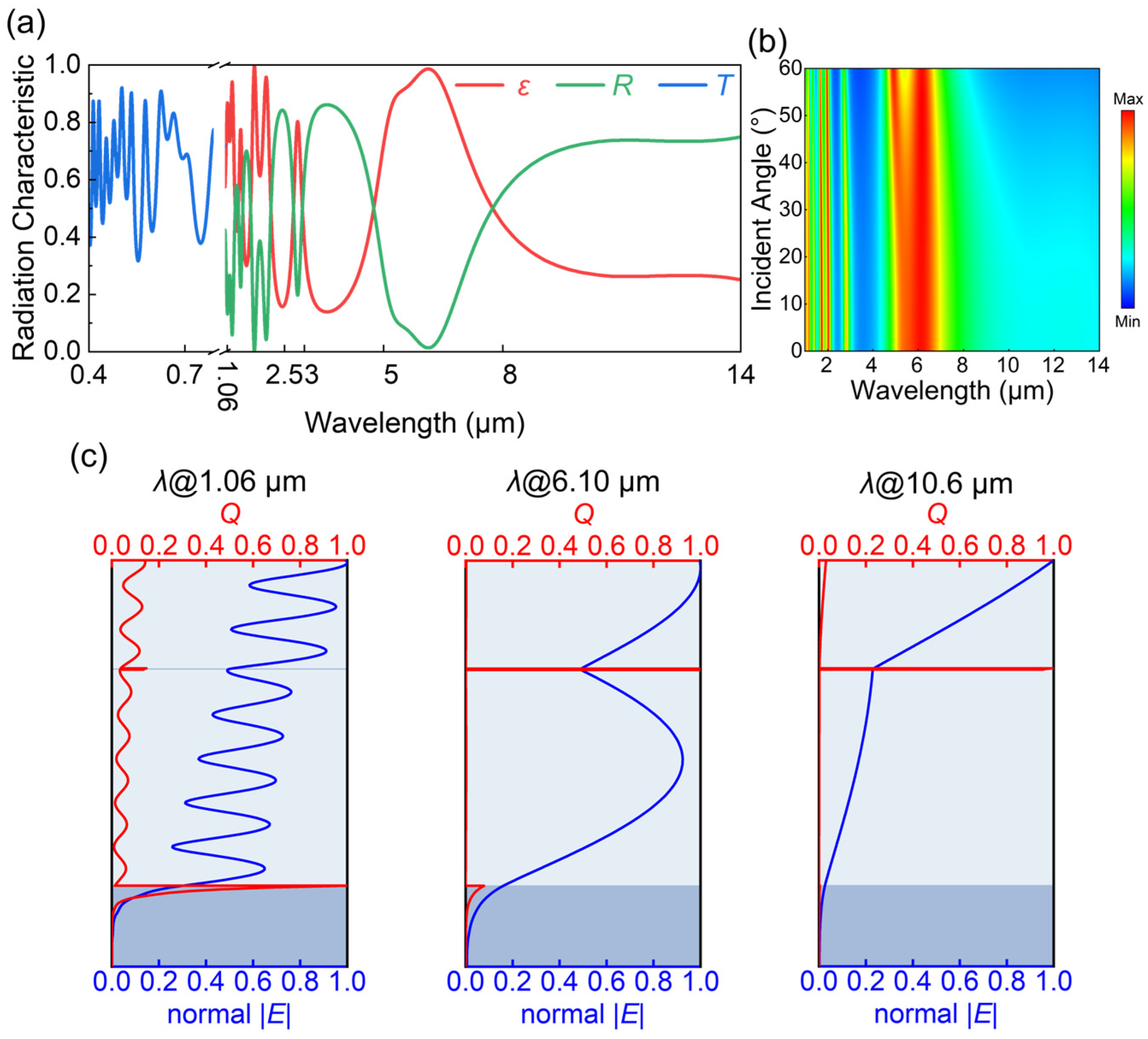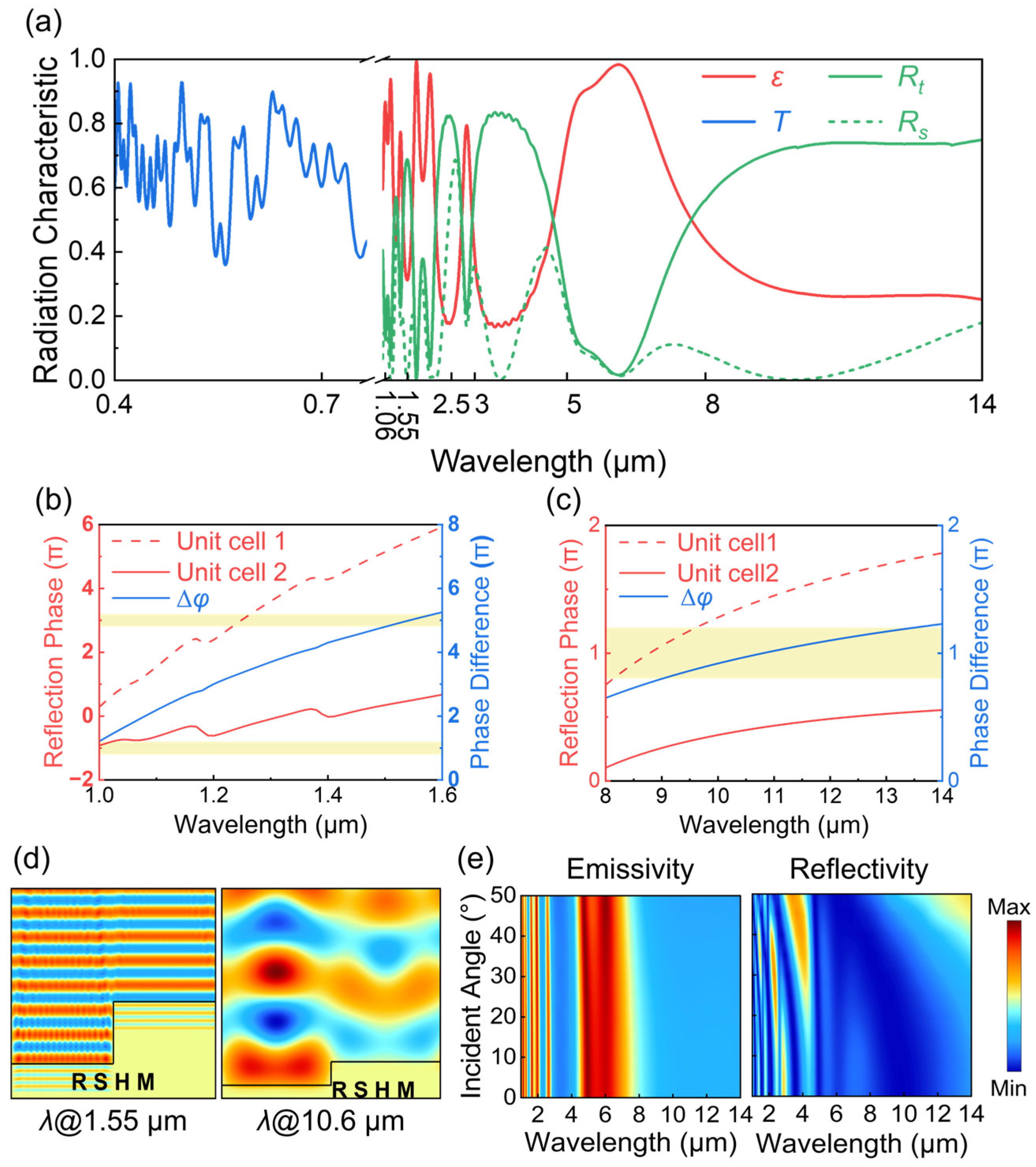Multifunctional Hierarchical Metamaterials: Synergizing Visible-Laser-Infrared Camouflage with Thermal Management
Abstract
1. Introduction
2. Design and Method
3. Results and Discussion
4. Conclusions
Supplementary Materials
Author Contributions
Funding
Institutional Review Board Statement
Informed Consent Statement
Data Availability Statement
Conflicts of Interest
References
- Du, K.K.; Li, Q.; Lyu, Y.B.; Ding, J.C.; Lu, Y.; Cheng, Z.Y.; Qiu, M. Control over emissivity of zero-static-power thermal emitters based on phase-changing material GST. Light Sci. Appl. 2017, 6, e16194. [Google Scholar] [CrossRef] [PubMed]
- Pan, M.; Huang, Y.; Li, Q.; Luo, H.; Zhu, H.; Kaur, S.; Qiu, M. Multi-band middle-infrared-compatible camouflage with thermal management via simple photonic structures. Nano Energy 2020, 69, 104449. [Google Scholar] [CrossRef]
- Yu, K.; Zhang, W.; Qian, M.; Shen, P.; Liu, Y. Multiband metamaterial emitters for infrared and laser compatible stealth with thermal management based on dissipative dielectrics. Photonics Res. 2023, 11, 290–298. [Google Scholar] [CrossRef]
- Kang, Q.; Li, D.; Wang, W.; Guo, K.; Guo, Z. Multiband tunable thermal camouflage compatible with laser camouflage based on GST plasmonic metamaterial. J. Phys. D Appl. Phys. 2021, 55, 065103. [Google Scholar] [CrossRef]
- Wu, L.; Yang, L.; Zhu, X.; Cai, B.; Cheng, Y. Ultra-broadband and wide-angle plasmonic absorber based on all-dielectric gallium arsenide pyramid nanostructure for full solar radiation spectrum range. Int. J. Therm. Sci. 2024, 201, 109043. [Google Scholar] [CrossRef]
- Liu, B.; Chen, Z.S.; Li, Z.G.; Shi, J.M.; Zhao, D.P.; Liu, L.P.; Wang, H. Design and preparation of multispectral stealth photonic crystals for visible light, infrared radiation, and 1.06-μm laser. Opt. Eng. 2020, 59, 127107. [Google Scholar] [CrossRef]
- Fleming, J.G.; Lin, S.Y.; El-Kady, I.; Biswas, R.; Ho, K.M. All-metallic three-dimensional photonic crystals with a large infrared bandgap. Nature 2002, 417, 52–55. [Google Scholar] [CrossRef]
- Luo, J.; Lai, Y. Near-perfect absorption by photonic crystals with a broadband and omnidirectional impedance-matching property. Opt. Express 2019, 27, 15800–15811. [Google Scholar] [CrossRef]
- Tong, H.; Li, H.; Huang, H.; Wu, A.; Cao, T.; Guo, D. Achievement of low infrared emissivity photonic crystal design on [CdSe/SiO2]N periodic films. Opt. Laser Technol. 2022, 156, 108557. [Google Scholar] [CrossRef]
- Zhu, H.; Li, Q.; Tao, C.; Hong, Y.; Xu, Z.; Shen, W.; Kaur, S.; Ghosh, P.; Qiu, M. Multispectral camouflage for infrared, visible, lasers and microwave with radiative cooling. Nat. Commun. 2021, 12, 1805. [Google Scholar] [CrossRef]
- Jiang, X.; Yuan, H.; He, X.; Du, T.; Ma, H.; Li, X.; Luo, M.; Zhang, Z.; Chen, H.; Yu, Y.; et al. Implementing of infrared camouflage with thermal management based on inverse design and hierarchical metamaterial. Nanophotonics 2023, 12, 1891–1902. [Google Scholar] [CrossRef] [PubMed]
- Deng, Z.; Su, Y.; Qin, W.; Wang, T.; Wang, X.; Gong, R. Nanostructured Ge/ZnS films for multispectral camouflage with low visibility and low thermal emission. ACS Appl. Nano Mater. 2022, 5, 5119–5127. [Google Scholar] [CrossRef]
- Huang, Y.; Zhu, Y.; Qin, B.; Zhou, Y.; Qin, R.; Ghosh, P.; Qiu, M.; Li, Q. Hierarchical visible-infrared- microwave scattering surfaces for multispectral camouflage. Nanophotonics 2022, 11, 3613–3622. [Google Scholar] [CrossRef]
- Feng, X.; Pu, M.; Zhang, F.; Pan, R.; Wang, S.; Gong, J.; Zhang, R.; Guo, Y.; Li, X.; Ma, X.; et al. Large-area low-cost multiscale-hierarchical metasurfaces for multispectral compatible camouflage of cual-band lasers, infrared and microwave. Adv. Funct. Mater. 2022, 32, 2205547. [Google Scholar] [CrossRef]
- Park, C.; Kim, J.; Hahn, J.W. Integrated infrared signature management with multispectral selective absorber via single-port grating resonance. Adv. Opt. Mater. 2021, 9, 2002225. [Google Scholar] [CrossRef]
- Huang, J.; Wang, Y.; Yuan, L.; Huang, C.; Liao, J.; Ji, C.; Luo, X. Large-area and flexible plasmonic metasurface for laser–infrared compatible camouflage. Laser Photonics Rev. 2023, 17, 2200616. [Google Scholar] [CrossRef]
- Zhou, Y.; Layani, M.; Boey, F.Y.C.; Sokolov, I.; Magdassi, S.; Long, Y. Electro-thermochromic devices composed of self-assembled transparent electrodes and hydrogels. Adv. Mater. Technol. 2016, 1, 1600069. [Google Scholar] [CrossRef]
- Meng, W.; Kragt, A.J.; Gao, Y.; Brembilla, E.; Hu, X.; Burgt, J.S.; Schenning, A.P.H.J.; Klein, T.; Zhou, G.; Ham, E.R.; et al. Scalable photochromic film for solar heat and daylight management. Adv. Mater. 2024, 36, 2304910. [Google Scholar] [CrossRef]
- Ma, T.; Li, B.; Zhu, Y.; Wu, S.; Zhao, X.; Chu, X.; Tian, S. Enhanced photochromic performance of Zn-doped W18O49-based films for smart windows. J. Mater. Chem. C 2024, 12, 10218–10225. [Google Scholar] [CrossRef]
- Xu, C.; Colorado Escobar, M.; Gorodetsky, A.A. Stretchable cephalopod-inspired multimodal camouflage systems. Adv. Mater. 2020, 32, 1905717. [Google Scholar] [CrossRef]
- Li, D.; Chen, Q.; Huang, J.; Xu, H.; Lu, Y.; Song, W. Scalable-manufactured metamaterials for simultaneous visible transmission, infrared reflection, and microwave absorption. ACS Appl. Mater. Interfaces 2022, 14, 33933–33943. [Google Scholar] [CrossRef] [PubMed]
- Chen, W.; Balanis, C.A.; Birtcher, C.R. Checkerboard EBG surfaces for wideband radar cross section reduction. IEEE Trans. Antennas Propag. 2015, 63, 2636–2645. [Google Scholar] [CrossRef]
- Galarregui, J.C.I.; Pereda, A.T.; De Falcon, J.L.M.; Ederra, I.; Gonzalo, R.; De Maagt, P. Broadband radar cross-section reduction using AMC technology. IEEE Trans. Antennas Propag. 2013, 61, 6136–6143. [Google Scholar] [CrossRef]
- Wang, L.; Zhang, S.; Dong, J.; Ma, L.; Zheng, C.; Zhang, W.; Liu, L. Multi-band infrared camouflage compatible with radiative cooling and visible colors via a simple multilayer film structure. Opt. Mater. Express 2023, 13, 2746. [Google Scholar] [CrossRef]
- Huang, Y.; Ma, B.; Pattanayak, A.; Kaur, S.; Qiu, M.; Li, Q. Infrared camouflage utilizing ultrathin flexible large-scale high-temperature-tolerant lambertian surfaces. Laser Photonics Rev. 2021, 15, 2000391. [Google Scholar] [CrossRef]
- Deng, Z.; Hu, W.; Zhou, P.; Huang, L.; Wang, T.; Wang, X.; Gong, R. Broadband tunable laser and infrared camouflage by wavelength-selective scattering metamaterial with radiative thermal management. Opt. Lett. 2024, 49, 935–938. [Google Scholar] [CrossRef]
- Li, X.; Chen, J.; Jiang, X.; Zeng, J.; Liao, X.; Chen, Y.; Xiao, S.; Zhao, F.; Chen, H.; Yang, J.; et al. Multispectral camouflage nanostructure design based on a particle swarm optimization algorithm for color camouflage, infrared camouflage, laser stealth, and heat dissipation. Opt. Express 2023, 31, 44811–44822. [Google Scholar] [CrossRef]
- Kim, J.; Park, C.; Hahn, J.W. Metal–semiconductor–metal metasurface for multiband infrared stealth technology using camouflage color pattern in visible range. Adv. Opt. Mater. 2022, 10, 2101930. [Google Scholar] [CrossRef]




| Structure | Material | Camouflage Band (μm) | Thermal Management (μm) | Ref. | ||||||
| Visible | Laser | Infrared | ||||||||
| 1.06 | 1.55 | 10.6 | 3–5 | 8–14 | 2.5–3 | 5–8 | ||||
| 9-layer film | SiO2/Ge/TiO2 | √ | √ | × | √ | √ | √ | × | √ | [24] |
| 7-layer film | Au/ZnS/Ge/Pt/SiO2 | × | √ | √ | √ | √ | √ | × | √ | [11] |
| Lambert | Al | × | √ | √ | √ | √ | × | × | [25] | |
| Meta-surface | Ge/ZnS | × | √ | √ | √ | √ | √ | × | √ | [26] |
| Meta-surface | Au/Ge/Ti/Ge | × | √ | √ | √ | √ | √ | × | × | [16] |
| Meta-surface | ZnS/Ge/SiO2/Pt/Au/Ag | × | √ | √ | √ | √ | √ | × | √ | [27] |
| Meta-surface | Al/Ge/Ag | √ | √ | × | × | √ | √ | × | × | [28] |
| Meta-surface | SiC/Ag/ITO | √ | √ | √ | √ | √ | √ | √ | √ | This work |
Disclaimer/Publisher’s Note: The statements, opinions and data contained in all publications are solely those of the individual author(s) and contributor(s) and not of MDPI and/or the editor(s). MDPI and/or the editor(s) disclaim responsibility for any injury to people or property resulting from any ideas, methods, instructions or products referred to in the content. |
© 2025 by the authors. Licensee MDPI, Basel, Switzerland. This article is an open access article distributed under the terms and conditions of the Creative Commons Attribution (CC BY) license (https://creativecommons.org/licenses/by/4.0/).
Share and Cite
Wu, S.; Huang, H.; Huang, Z.; Tian, C.; Guo, L.; Liu, Y.; Liu, S. Multifunctional Hierarchical Metamaterials: Synergizing Visible-Laser-Infrared Camouflage with Thermal Management. Photonics 2025, 12, 387. https://doi.org/10.3390/photonics12040387
Wu S, Huang H, Huang Z, Tian C, Guo L, Liu Y, Liu S. Multifunctional Hierarchical Metamaterials: Synergizing Visible-Laser-Infrared Camouflage with Thermal Management. Photonics. 2025; 12(4):387. https://doi.org/10.3390/photonics12040387
Chicago/Turabian StyleWu, Shenglan, Hao Huang, Zhenyong Huang, Chunhui Tian, Lina Guo, Yong Liu, and Shuang Liu. 2025. "Multifunctional Hierarchical Metamaterials: Synergizing Visible-Laser-Infrared Camouflage with Thermal Management" Photonics 12, no. 4: 387. https://doi.org/10.3390/photonics12040387
APA StyleWu, S., Huang, H., Huang, Z., Tian, C., Guo, L., Liu, Y., & Liu, S. (2025). Multifunctional Hierarchical Metamaterials: Synergizing Visible-Laser-Infrared Camouflage with Thermal Management. Photonics, 12(4), 387. https://doi.org/10.3390/photonics12040387





